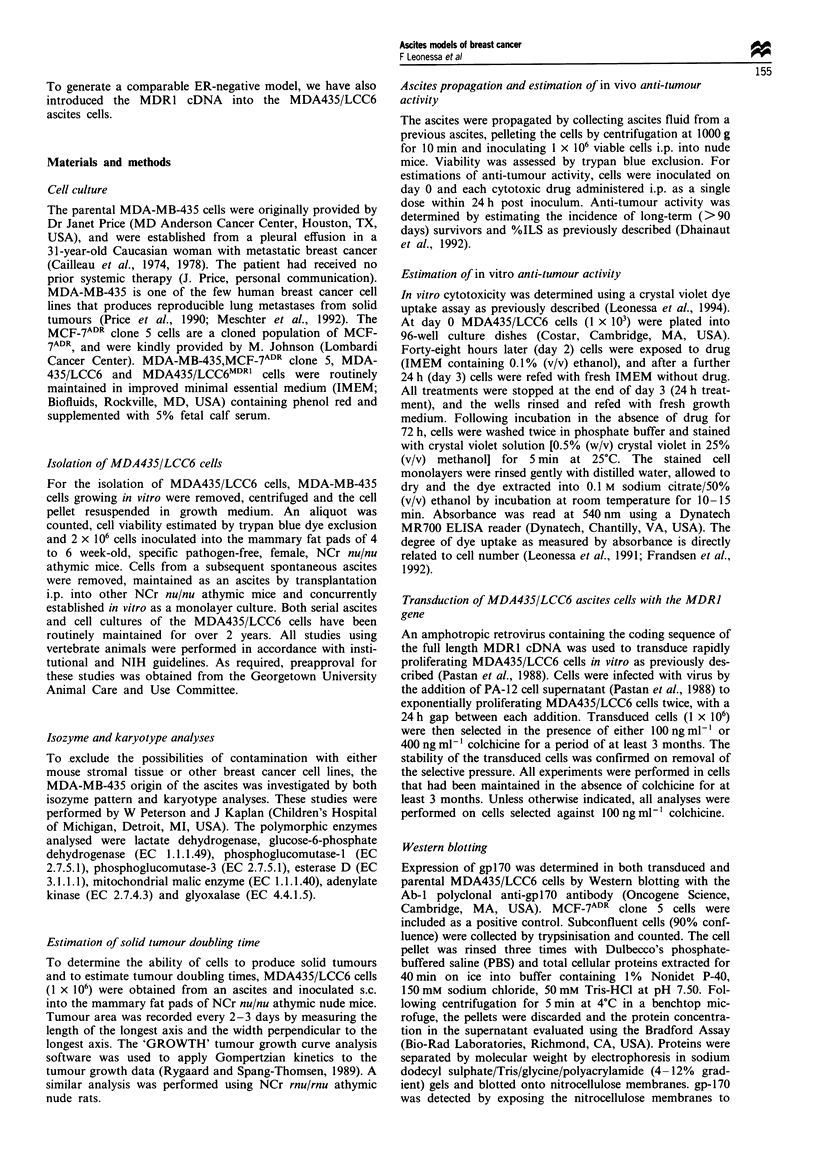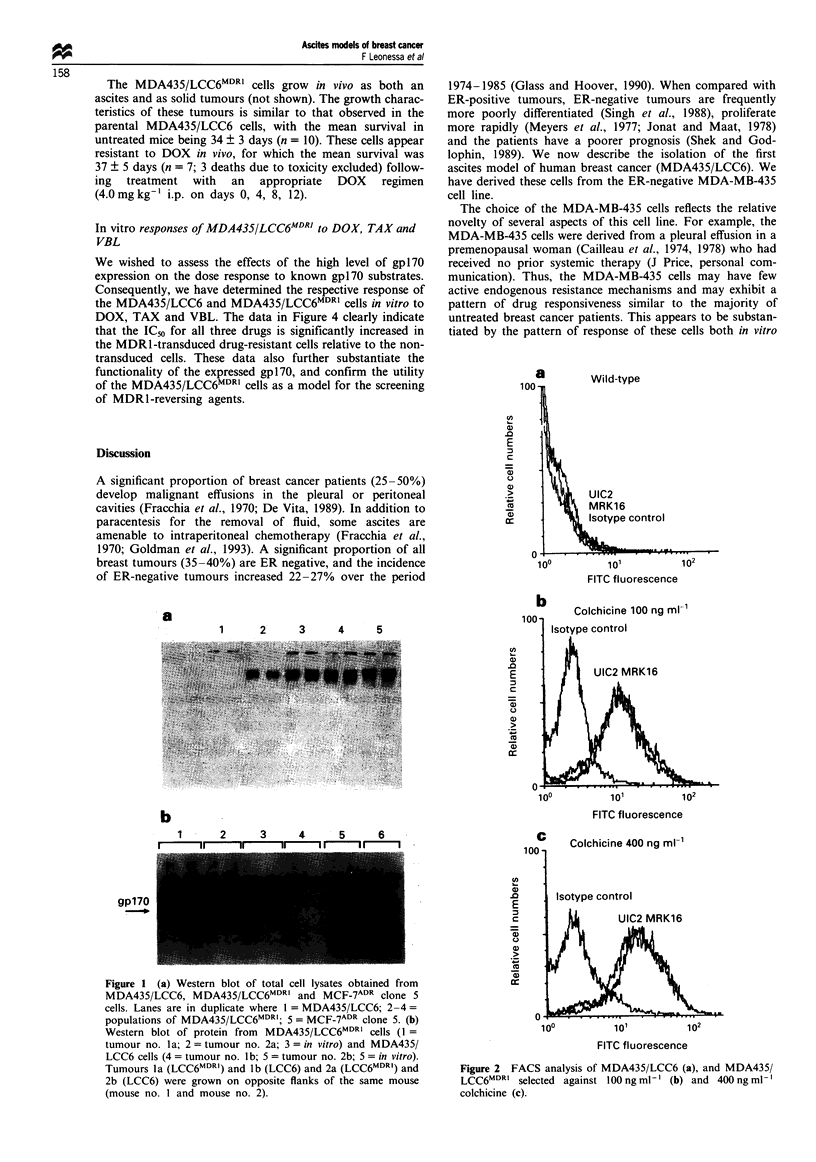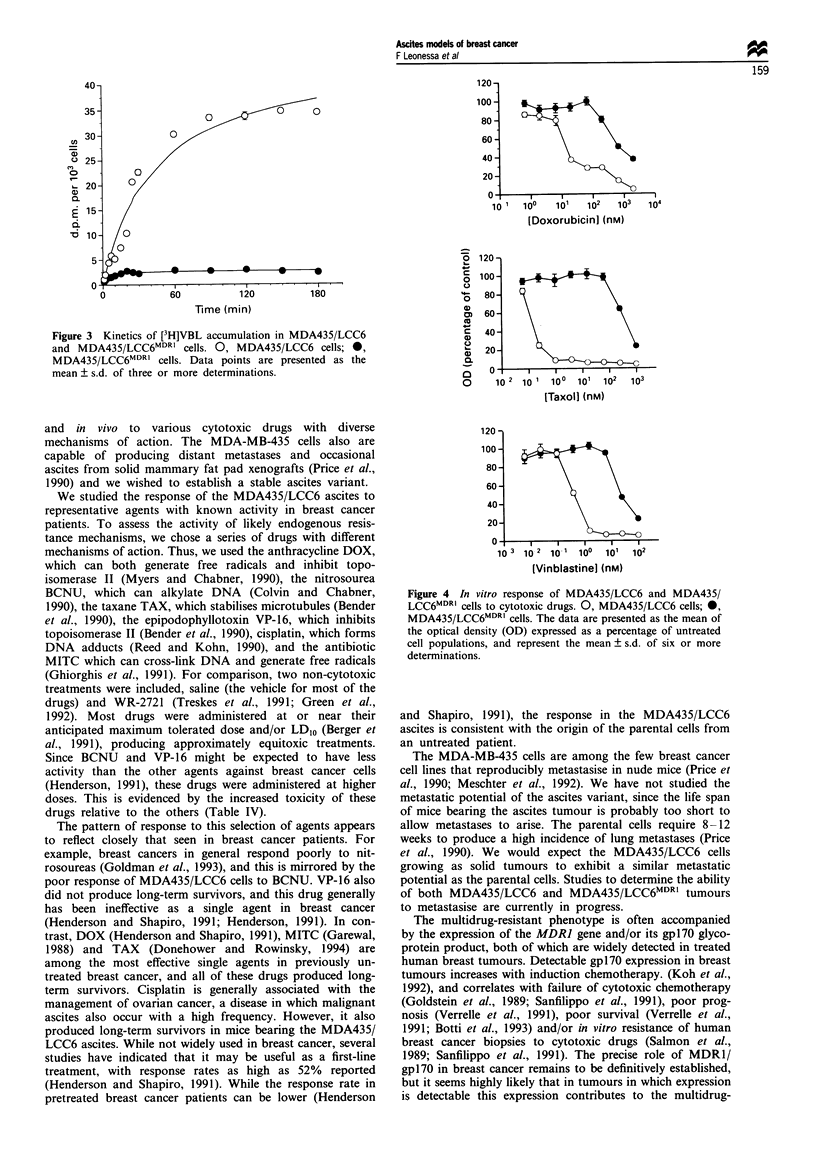Abstract
We have established a novel ascites tumour model (MDA435/LCC6) from the oestrogen receptor-negative, invasive and metastatic MDA-MB-435 human breast cancer cell line. MDA435/LCC6 cells grow as both malignant ascites and solid tumours in vivo in nude mice and nude rats, with a tumour incidence of approximately 100%. Untreated mice develop ascites following i.p. inoculation of 1 x 10(6) cells and have a reproducible life span of approximately 30 days, with all animals dying within a 48 h period. The in vivo response of MDA435/LCC6 ascites to several cytotoxic drugs, including doxorubicin, etoposide (VP-16), BCNU and mitomycin C, closely reflects the activity of these single agents in previously untreated breast cancer patients. MDA435/LCC6 cells also retain the anchorage-dependent and anchorage-independent in vitro growth properties of the parental MDA-MB-435 cells, and can be used in standard in vitro drug screening assays. The drug resistance pattern of the MDA435/LCC6 cells suggests that they may have few active endogenous drug resistance mechanisms. To generate a model for the screening of MDR1-reversing agents, MDA435/LCC6 were transduced with a retroviral vector directing the constitutive expression of the MDR1 cDNA, producing a cell line with a classical MDR1 resistance pattern (MDA435/LCC6MDR1). THese ascites models may be a viable alternative to the murine leukaemia ascites (L1210, P388) and, in conjunction with other breast cancer cell lines, facilitate the in vitro and in vivo screening of new cytotoxic drugs and drug combinations.
Full text
PDF







Images in this article
Selected References
These references are in PubMed. This may not be the complete list of references from this article.
- Batist G., Tulpule A., Sinha B. K., Katki A. G., Myers C. E., Cowan K. H. Overexpression of a novel anionic glutathione transferase in multidrug-resistant human breast cancer cells. J Biol Chem. 1986 Nov 25;261(33):15544–15549. [PubMed] [Google Scholar]
- Botti G., Chiappetta G., D'Aiuto G., de Angelis E., De Matteis A., Montella M., Picone A., Cascione F. PCNA/cyclin and P-glycoprotein as prognostic factors in locally advanced breast cancer. An immunohistochemical, retrospective study. Tumori. 1993 Jun 30;79(3):214–218. doi: 10.1177/030089169307900312. [DOI] [PubMed] [Google Scholar]
- Cailleau R., Olivé M., Cruciger Q. V. Long-term human breast carcinoma cell lines of metastatic origin: preliminary characterization. In Vitro. 1978 Nov;14(11):911–915. doi: 10.1007/BF02616120. [DOI] [PubMed] [Google Scholar]
- Cailleau R., Young R., Olivé M., Reeves W. J., Jr Breast tumor cell lines from pleural effusions. J Natl Cancer Inst. 1974 Sep;53(3):661–674. doi: 10.1093/jnci/53.3.661. [DOI] [PMC free article] [PubMed] [Google Scholar]
- Clarke R., Brünner N., Thompson E. W., Glanz P., Katz D., Dickson R. B., Lippman M. E. The inter-relationships between ovarian-independent growth, tumorigenicity, invasiveness and antioestrogen resistance in the malignant progression of human breast cancer. J Endocrinol. 1989 Jul;122(1):331–340. doi: 10.1677/joe.0.1220331. [DOI] [PubMed] [Google Scholar]
- Clarke R., Currier S., Kaplan O., Lovelace E., Boulay V., Gottesman M. M., Dickson R. B. Effect of P-glycoprotein expression on sensitivity to hormones in MCF-7 human breast cancer cells. J Natl Cancer Inst. 1992 Oct 7;84(19):1506–1512. doi: 10.1093/jnci/84.19.1506. [DOI] [PubMed] [Google Scholar]
- Clarke R., Dickson R. B., Lippman M. E. Hormonal aspects of breast cancer. Growth factors, drugs and stromal interactions. Crit Rev Oncol Hematol. 1992 Jan;12(1):1–23. doi: 10.1016/1040-8428(92)90062-u. [DOI] [PubMed] [Google Scholar]
- Dhainaut A., Régnier G., Atassi G., Pierré A., Léonce S., Kraus-Berthier L., Prost J. F. New triazine derivatives as potent modulators of multidrug resistance. J Med Chem. 1992 Jun 26;35(13):2481–2496. doi: 10.1021/jm00091a017. [DOI] [PubMed] [Google Scholar]
- Ford J. M., Bruggemann E. P., Pastan I., Gottesman M. M., Hait W. N. Cellular and biochemical characterization of thioxanthenes for reversal of multidrug resistance in human and murine cell lines. Cancer Res. 1990 Mar 15;50(6):1748–1756. [PubMed] [Google Scholar]
- Fracchia A. A., Knapper W. H., Carey J. T., Farrow J. H. Intrapleural chemotherapy for effusion from metastatic breast carcinoma. Cancer. 1970 Sep;26(3):626–629. doi: 10.1002/1097-0142(197009)26:3<626::aid-cncr2820260320>3.0.co;2-3. [DOI] [PubMed] [Google Scholar]
- Garewal H. S. Mitomycin C in the chemotherapy of advanced breast cancer. Semin Oncol. 1988 Jun;15(3 Suppl 4):74–79. [PubMed] [Google Scholar]
- Ghiorghis A., Talebian A., Clarke R. In vitro antineoplastic activity of C7-substituted mitomycin C analogues MC-77 and MC-62 against human breast-cancer cell lines. Cancer Chemother Pharmacol. 1992;29(4):290–296. doi: 10.1007/BF00685947. [DOI] [PubMed] [Google Scholar]
- Glass A. G., Hoover R. N. Rising incidence of breast cancer: relationship to stage and receptor status. J Natl Cancer Inst. 1990 Apr 18;82(8):693–696. doi: 10.1093/jnci/82.8.693. [DOI] [PubMed] [Google Scholar]
- Goldman C. A., Skinnider L. F., Maksymiuk A. W. Interferon instillation for malignant pleural effusions. Ann Oncol. 1993 Feb;4(2):141–145. doi: 10.1093/oxfordjournals.annonc.a058416. [DOI] [PubMed] [Google Scholar]
- Goldstein L. J., Galski H., Fojo A., Willingham M., Lai S. L., Gazdar A., Pirker R., Green A., Crist W., Brodeur G. M. Expression of a multidrug resistance gene in human cancers. J Natl Cancer Inst. 1989 Jan 18;81(2):116–124. doi: 10.1093/jnci/81.2.116. [DOI] [PubMed] [Google Scholar]
- Jonat W., Maass H. Some comments on the necessity of receptor determination in human breast cancer. Cancer Res. 1978 Nov;38(11 Pt 2):4305–4306. [PubMed] [Google Scholar]
- Koh E. H., Chung H. C., Lee K. B., Lim H. Y., Kim J. H., Roh J. K., Min J. S., Lee K. S., Kim B. S. The value of immunohistochemical detection of P-glycoprotein in breast cancer before and after induction chemotherapy. Yonsei Med J. 1992 Jun;33(2):137–142. doi: 10.3349/ymj.1992.33.2.137. [DOI] [PubMed] [Google Scholar]
- Leonessa F., Boulay V., Wright A., Thompson E. W., Brünner N., Clarke R. The biology of breast tumor progression. Acquisition of hormone independence and resistance to cytotoxic drugs. Acta Oncol. 1992;31(2):115–123. doi: 10.3109/02841869209088890. [DOI] [PubMed] [Google Scholar]
- Leonessa F., Jacobson M., Boyle B., Lippman J., McGarvey M., Clarke R. Effect of tamoxifen on the multidrug-resistant phenotype in human breast cancer cells: isobologram, drug accumulation, and M(r) 170,000 glycoprotein (gp170) binding studies. Cancer Res. 1994 Jan 15;54(2):441–447. [PubMed] [Google Scholar]
- Meschter C. L., Connolly J. M., Rose D. P. Influence of regional location of the inoculation site and dietary fat on the pathology of MDA-MB-435 human breast cancer cell-derived tumors grown in nude mice. Clin Exp Metastasis. 1992 May;10(3):167–173. doi: 10.1007/BF00132748. [DOI] [PubMed] [Google Scholar]
- Meyer J. S., Rao B. R., Stevens S. C., White W. L. Low incidence of estrogen receptor in breast carcinomas with rapid rates of cellular replication. Cancer. 1977 Nov;40(5):2290–2298. doi: 10.1002/1097-0142(197711)40:5<2290::aid-cncr2820400541>3.0.co;2-t. [DOI] [PubMed] [Google Scholar]
- Miller A. B., Bulbrook R. D. UICC Multidisciplinary Project on Breast Cancer: the epidemiology, aetiology and prevention of breast cancer. Int J Cancer. 1986 Feb 15;37(2):173–177. doi: 10.1002/ijc.2910370202. [DOI] [PubMed] [Google Scholar]
- Pastan I., Gottesman M. M., Ueda K., Lovelace E., Rutherford A. V., Willingham M. C. A retrovirus carrying an MDR1 cDNA confers multidrug resistance and polarized expression of P-glycoprotein in MDCK cells. Proc Natl Acad Sci U S A. 1988 Jun;85(12):4486–4490. doi: 10.1073/pnas.85.12.4486. [DOI] [PMC free article] [PubMed] [Google Scholar]
- Price J. E., Polyzos A., Zhang R. D., Daniels L. M. Tumorigenicity and metastasis of human breast carcinoma cell lines in nude mice. Cancer Res. 1990 Feb 1;50(3):717–721. [PubMed] [Google Scholar]
- Ramu A., Glaubiger D., Fuks Z. Reversal of acquired resistance to doxorubicin in P388 murine leukemia cells by tamoxifen and other triparanol analogues. Cancer Res. 1984 Oct;44(10):4392–4395. [PubMed] [Google Scholar]
- Salmon S. E., Grogan T. M., Miller T., Scheper R., Dalton W. S. Prediction of doxorubicin resistance in vitro in myeloma, lymphoma, and breast cancer by P-glycoprotein staining. J Natl Cancer Inst. 1989 May 3;81(9):696–701. doi: 10.1093/jnci/81.9.696. [DOI] [PubMed] [Google Scholar]
- Sanfilippo O., Ronchi E., De Marco C., Di Fronzo G., Silvestrini R. Expression of P-glycoprotein in breast cancer tissue and in vitro resistance to doxorubicin and vincristine. Eur J Cancer. 1991;27(2):155–158. doi: 10.1016/0277-5379(91)90476-t. [DOI] [PubMed] [Google Scholar]
- Schneider J., Bak M., Efferth T., Kaufmann M., Mattern J., Volm M. P-glycoprotein expression in treated and untreated human breast cancer. Br J Cancer. 1989 Dec;60(6):815–818. doi: 10.1038/bjc.1989.372. [DOI] [PMC free article] [PubMed] [Google Scholar]
- Shek L. L., Godolphin W. Survival with breast cancer: the importance of estrogen receptor quantity. Eur J Cancer Clin Oncol. 1989 Feb;25(2):243–250. doi: 10.1016/0277-5379(89)90015-1. [DOI] [PubMed] [Google Scholar]
- Siciliano M. J., Barker P. E., Cailleau R. Mutually exclusive genetic signatures of human breast tumor cell lines with a common chromosomal marker. Cancer Res. 1979 Mar;39(3):919–922. [PubMed] [Google Scholar]
- Singh L., Wilson A. J., Baum M., Whimster W. F., Birch I. H., Jackson I. M., Lowrey C., Palmer M. K. The relationship between histological grade, oestrogen receptor status, events and survival at 8 years in the NATO ('Nolvadex') trial. Br J Cancer. 1988 Jun;57(6):612–614. doi: 10.1038/bjc.1988.139. [DOI] [PMC free article] [PubMed] [Google Scholar]
- Sinha B. K., Mimnaugh E. G., Rajagopalan S., Myers C. E. Adriamycin activation and oxygen free radical formation in human breast tumor cells: protective role of glutathione peroxidase in adriamycin resistance. Cancer Res. 1989 Jul 15;49(14):3844–3848. [PubMed] [Google Scholar]
- Treskes M., Holwerda U., Klein I., Pinedo H. M., van der Vijgh W. J. The chemical reactivity of the modulating agent WR2721 (ethiofos) and its main metabolites with the antitumor agents cisplatin and carboplatin. Biochem Pharmacol. 1991 Nov 6;42(11):2125–2130. doi: 10.1016/0006-2952(91)90347-8. [DOI] [PubMed] [Google Scholar]
- Veneroni S., Zaffaroni N., Daidone M. G., Benini E., Villa R., Silvestrini R. Expression of P-glycoprotein and in vitro or in vivo resistance to doxorubicin and cisplatin in breast and ovarian cancers. Eur J Cancer. 1994;30A(7):1002–1007. doi: 10.1016/0959-8049(94)90132-5. [DOI] [PubMed] [Google Scholar]
- Verrelle P., Meissonnier F., Fonck Y., Feillel V., Dionet C., Kwiatkowski F., Plagne R., Chassagne J. Clinical relevance of immunohistochemical detection of multidrug resistance P-glycoprotein in breast carcinoma. J Natl Cancer Inst. 1991 Jan 16;83(2):111–116. doi: 10.1093/jnci/83.2.111. [DOI] [PubMed] [Google Scholar]
- Vickers P. J., Dickson R. B., Shoemaker R., Cowan K. H. A multidrug-resistant MCF-7 human breast cancer cell line which exhibits cross-resistance to antiestrogens and hormone-independent tumor growth in vivo. Mol Endocrinol. 1988 Oct;2(10):886–892. doi: 10.1210/mend-2-10-886. [DOI] [PubMed] [Google Scholar]
- Zyad A., Bénard J., Tursz T., Clarke R., Chouaib S. Resistance to TNF-alpha and adriamycin in the human breast cancer MCF-7 cell line: relationship to MDR1, MnSOD, and TNF gene expression. Cancer Res. 1994 Feb 1;54(3):825–831. [PubMed] [Google Scholar]



